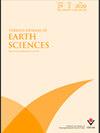东南安纳托利亚造山带叠瓦带发育:来自Gölbaşı地区(土耳其东南部)裂变径迹热年代学的证据
IF 1.1
4区 地球科学
Q3 GEOSCIENCES, MULTIDISCIPLINARY
引用次数: 1
摘要
大陆碰撞带的主要组成部分之一是叠瓦构造带。东南安纳托利亚造山带(SAOB)的这一构造带完全受至少晚白垩世以来安纳托利亚板块与阿拉伯地台之间仍然活跃的辐合和吸积系统控制。该带的特征是北东东/西南西向、北倾的逆冲断层,挤压在北部的Tauride地块和南部的阿拉伯地台之间。在该区内出现的单元包括与新特提斯有关的岩浆、蛇绿岩、沉积岩和变质岩,其形成/变质期为晚白垩世至中新世。Karanlıkdere花岗岩类侵入晚白垩世梅丹蛇绿岩、Helete火山岩和Malatya变质岩。这些单位在新生代火山岩和沉积岩上逆冲。尽管对该复杂地区晚白垩世至新近纪的演化提出了多种设想,但旨在了解该地区叠瓦带生长机制的定量数据有限。应用锆石U-Pb和磷灰石裂变径迹(AFT)热年代学对东南安纳托利亚造山带叠瓦带Karanlıkdere花岗岩类进行了研究。LA-ICP-MS锆石U- pb年龄为79.67±0.24 Ma, Th/U比值为0.23 ~ 0.65。这一年龄比前人公布的年龄略小,说明Karanlıkdere花岗岩类主体形成时间比侵入其他单元的小岩脉晚3 ~ 4 Ma。在40.38±3.4 Ma和22.81±0.63 Ma之间,AFT年龄受海拔高度直接控制。年龄最大的AFT年龄高度最高,而年龄最小的AFT年龄高度最低。年龄-温度模式显示在40 ~ 22 Ma之间抬升速率缓慢。结果表明,在始新世中晚期至中新世早期,南洋逆推覆体前叠瓦带以缓慢的隆升速率(0.02±0.005 mm/a)增长,在中新世早期至中中新世早期隆升速率加快,这可能与中新世早期的大陆碰撞有关。本文章由计算机程序翻译,如有差异,请以英文原文为准。
Growth of the imbrication zone along the southeast Anatolian orogenic belt: evidencefrom fission track thermochronology from Gölbaşı region (SE Turkey)
: One of the major components of continental collision zones is their imbricated zones. Such a zone along the Southeast Anatolian Orogenic Belt (SAOB) is solely controlled by a still-active convergence and accretion system between the Anatolian Plate and Arabian platform since at least Late Cretaceous. The zone is characterized by NEE/SWW-trending, northward-dipping thrust slices that are squeezed between the Tauride Block to the north and the Arabian platform to the south. The units cropping out within the zone comprise Neo-Tethys-related magmatic, ophiolitic, sedimentary and metamorphic rocks with Late Cretaceous to Miocene formation/metamorphism ages. The Karanlıkdere granitoid intrudes into Late Cretaceous Meydan ophiolite, Helete volcanics, and Malatya metamorphics. These units thrust over Cenozoic volcanic and sedimentary rocks. Although various scenarios have been proposed for the late Cretaceous to Neogene evolution of the complex region, quantitative data aiming to understand the growth mechanism of the imbrication zone in the region are limited. The zircon U-Pb and the apatite fission track (AFT) thermochronology were applied to the Karanlıkdere granitoid within the imbrication zone of the Southeast Anatolian Orogenic Belt (SAOB). The LA-ICP-MS zircon U-Pb age yields 79.67 ± 0.24 Ma with 0.23–0.65 Th/U ratios. This age is slightly younger than the previously published ages, indicating that the main body of the Karanlıkdere granitoid formed 3-4 Ma later than the small dikes intruded into other units. The AFT ages are directly controlled by altitude and range between 40.38 ± 3.4 Ma and 22.81 ± 0.63 Ma. The oldest AFT age has the highest altitude, whereas the youngest has the lowest height. The age-temperature models show a slow uplift rate between 40 Ma and 22 Ma. The results indicate that the growth of the imbrication zone in front of the Nappes of the SAOB continued in a steady-state mode with a slow uplift rate of 0.02 ± 0.005 mm/a, during middle-late Eocene to early Miocene and increasing uplift rate during early-middle Miocene, which might be explained by continental collision during early-middle Miocene.
求助全文
通过发布文献求助,成功后即可免费获取论文全文。
去求助
来源期刊

Turkish Journal of Earth Sciences
地学-地球科学综合
CiteScore
2.40
自引率
10.00%
发文量
6
审稿时长
6 months
期刊介绍:
The Turkish Journal of Earth Sciences is published electronically 6 times a year by the Scientific and Technological Research
Council of Turkey (TÜBİTAK). It is an international English-language journal for the publication of significant original recent
research in a wide spectrum of topics in the earth sciences, such as geology, structural geology, tectonics, sedimentology,
geochemistry, geochronology, paleontology, igneous and metamorphic petrology, mineralogy, biostratigraphy, geophysics,
geomorphology, paleoecology and oceanography, and mineral deposits. Contribution is open to researchers of all nationalities.
 求助内容:
求助内容: 应助结果提醒方式:
应助结果提醒方式:


